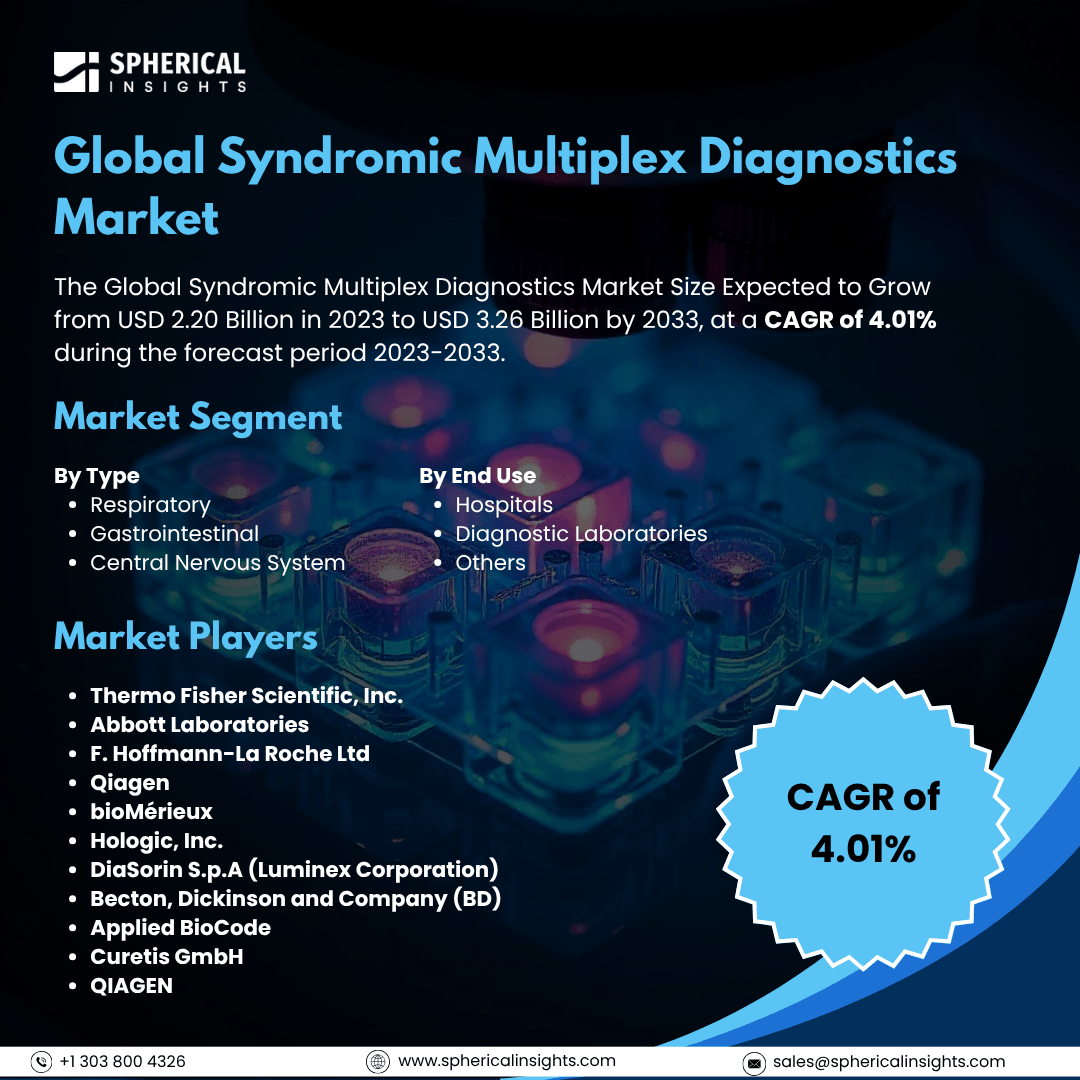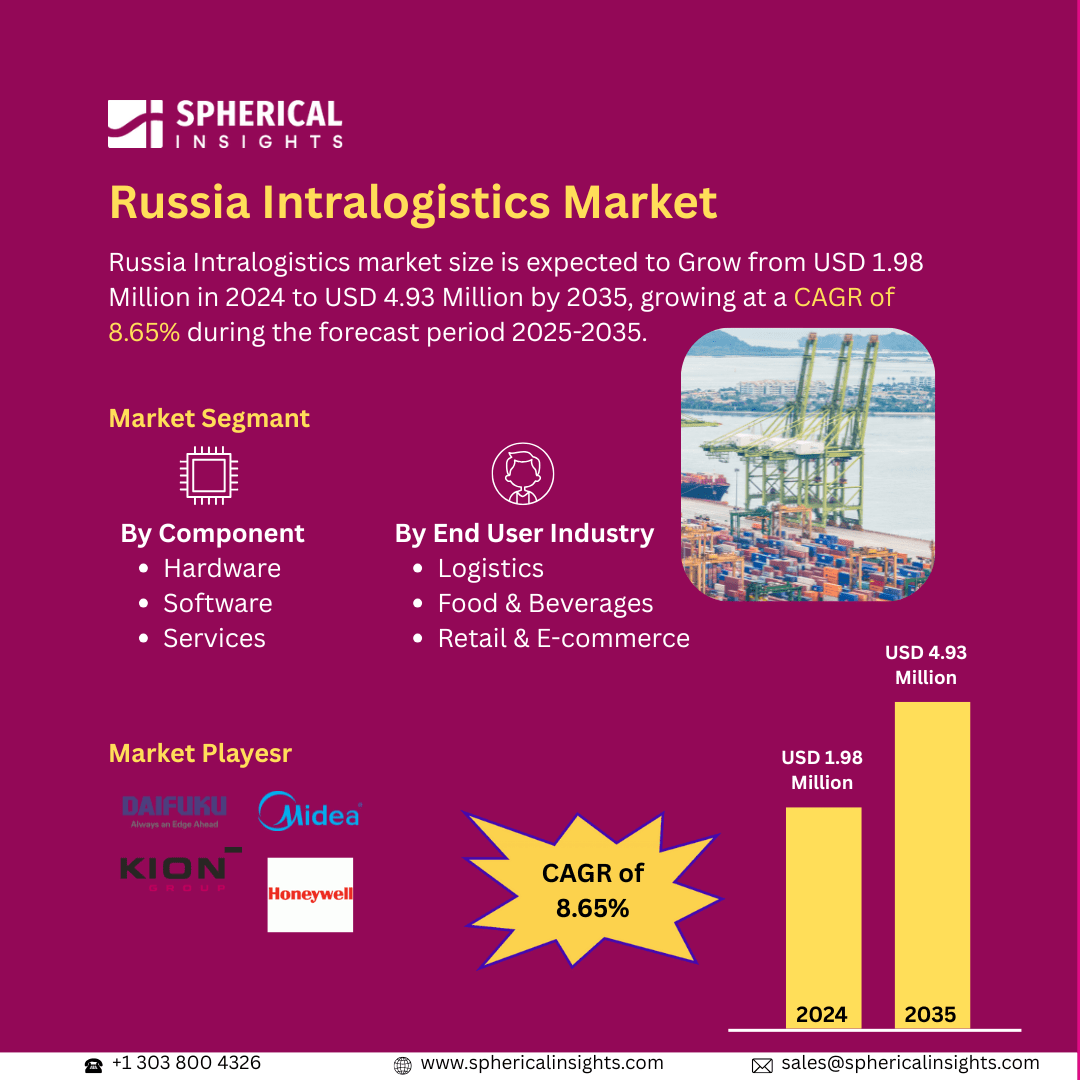Global Syndromic Multiplex Diagnostics Market Size to Exceed USD 3.26 Billion by 2033
According to a research report published by Spherical Insights & Consulting, The Global Syndromic Multiplex Diagnostics Market Size Expected to Grow from USD 2.20 Billion in 2023 to USD 3.26 Billion by 2033, at a CAGR of 4.01% during the forecast period 2023-2033.
Browse 210 market data Tables and 45 Figures spread through 190 Pages and in-depth TOC on the Global Syndromic Multiplex Diagnostics Market Size, Share, and COVID-19 Impact Analysis, By Type (Respiratory, Gastrointestinal, Central Nervous System), By End Use (Hospitals, Diagnostic Laboratories, Others), and By Region (North America, Europe, Asia Pacific, Latin America, Middle East, and Africa), Analysis and Forecast 2023 – 2033
The syndromic multiplex diagnostics market is the industry that deals with cutting-edge diagnostic tools that facilitate the detection of multiple pathogens or biomarkers simultaneously from one patient sample. They deliver quick, precise, and complete results, enhancing disease diagnosis, treatment, and patient outcomes, especially for infectious diseases, respiratory diseases, and gastrointestinal infections. Moreover, the syndromic multiplex diagnostics market is influenced by the increasing incidence of infectious diseases, demand for faster and more precise diagnostics, and innovation in molecular diagnostic technologies. Healthcare awareness, government support, and hospital and laboratory adoption of syndromic testing also increase market growth. Moreover, the transition towards personalized medicine and automation drives market growth. However, excessive cost of multiplex diagnostic tests, regulatory issues, and poor availability in developing countries hinder market growth. Furthermore, need for qualified professionals and possibility of cross-reactivity in tests are challenges.
The respiratory segment accounted for the largest share of the global syndromic multiplex diagnostics market in 2023 and is anticipated to grow at a significant CAGR during the forecast period.
On the basis of type, the global syndromic multiplex diagnostics market is divided into respiratory, gastrointestinal, and central nervous system. Among these, the respiratory segment accounted for the largest share of the global syndromic multiplex diagnostics market in 2023 and is anticipated to grow at a significant CAGR during the forecast period. This is because of the heavy burden of respiratory illnesses such as influenza, COVID-19, and RSV. The growing need for fast and accurate diagnostics, combined with technological advancements in molecular testing systems, further propels this segment to take over the market.
The hospitals segment accounted for a substantial share of the global syndromic multiplex Diagnostics market in 2023 and is anticipated to grow at a rapid pace during the projected period.
On the basis of the end use, the global syndromic multiplex diagnostics market is divided into hospitals, diagnostic laboratories, and others. Among these, the hospitals segment accounted for a substantial share of the global syndromic multiplex diagnostics market in 2023 and is anticipated to grow at a rapid pace during the projected period. This is owing to the great patient flow, presence of high-end diagnostic equipment, and extensive use of syndromic testing for urgent disease management. Besides, the importance of precise and quick diagnostics within emergency and inpatient environments even propels the supremacy of this segment.
North America is projected to hold the largest share of the global syndromic multiplex diagnostics market over the projected period.
North America is projected to hold the largest share of the global syndromic multiplex diagnostics market over the projected period. This is because of advanced healthcare infrastructure, high infectious disease burden, government support, and industry leaders. The rapid uptake of molecular diagnostics, higher investments, and growing awareness after COVID-19 also fuel market growth in the U.S. and Canada.
Europe is expected to grow at the fastest CAGR of the global syndromic multiplex diagnostics market during the projected period. This is due to rising healthcare spending, accelerating demand for quicker diagnostics, and supportive government measures. Germany, the U.K., and France are at the forefront because they possess sophisticated lab infrastructure, a high level of disease awareness, and increasing acceptance of molecular diagnostic technology.
Company Profiling
Major vendors in the global syndromic multiplex diagnostics market are Thermo Fisher Scientific, Inc., Abbott Laboratories, F. Hoffmann-La Roche Ltd, Qiagen, bioMérieux, Hologic, Inc., DiaSorin S.p.A (Luminex Corporation), Becton, Dickinson and Company (BD), Applied BioCode, Curetis GmbH, QIAGEN., and Others.
Key Target Audience
- Market Players
- Investors
- End-users
- Government Authorities
- Consulting and Research Firm
- Venture capitalists
- Value-Added Resellers (VARs)
Recent Development
- In December 2023, QuidelOrtho gained FDA 510(k) clearance for its Savanna multiplex molecular platform and the Savanna HSV 1+2/VZV PCR assay, allowing for quick detection and discrimination of HSV-1, HSV-2, and VZV from patient lesion samples. The platform provides results in about 25 minutes, improving diagnostic efficiency in a range of healthcare settings.
Market Segment
This study forecasts revenue at global, regional, and country levels from 2023 to 2033. Spherical Insights has segmented the global syndromic Multiplex Diagnostics market based on the below-mentioned segments:
Global Syndromic Multiplex Diagnostics Market, By Type
- Respiratory
- Gastrointestinal
- Central Nervous System
Global Syndromic Multiplex Diagnostics Market, By End Use
- Hospitals
- Diagnostic Laboratories
- Others
Global Syndromic Multiplex Diagnostics Market, By Regional
- North America
- Europe
- Germany
- UK
- France
- Italy
- Spain
- Russia
- Rest of Europe
- Asia Pacific
- China
- Japan
- India
- South Korea
- Australia
- Rest of Asia Pacific
- South America
- Brazil
- Argentina
- Rest of South America
- Middle East & Africa
- UAE
- Saudi Arabia
- Qatar
- South Africa
- Rest of the Middle East & Africa



